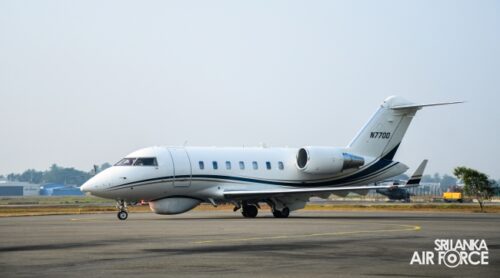A joint training program focusing on Intelligence, Surveillance, and Reconnaissance (ISR) operations commenced on Mar. 12, at the Sri Lanka Air Force (SLAF) Base Ratmalana. This initiative, facilitated collaboratively between the United States Department of Defense (DoD), the U.S. Embassy in Colombo, and the SLAF, aims to enhance Sri Lanka’s maritime domain awareness (MDA) capabilities.
The program offers Sri Lankan personnel comprehensive briefings on various maritime security topics. Additionally, the U.S. DoD deployed a Challenger 605 aircraft to Sri Lanka for the ISR flight demonstrations. This business jet, modified for maritime surveillance, will be used to showcase the capabilities of specialized airborne ISR platforms in conducting surveillance missions within Sri Lanka’s maritime domain. SLAF pilots will have the opportunity to train alongside U.S. personnel and gain firsthand experience in operating with such advanced surveillance aircraft. This combined approach equips Sri Lanka’s Tri-Services (Army, Navy, Air Force) with the necessary knowledge and operational skills to effectively monitor and safeguard their vast territorial waters.
The program’s inauguration ceremony on Mar. 12 included prominent figures such as Sri Lanka’s National Security Advisor, the U.S. Ambassador to Sri Lanka, and senior officers from the Sri Lanka Air Force and Navy. This signifies the strategic importance placed on this collaborative effort by both nations in ensuring regional maritime security.
The Challenger 605 that was deployed, registration N7700, bears a strong resemblance to the Boeing Maritime Surveillance Aircraft (MSA) initiative. Both aircraft are Bombadier Chelleger 605 jets modified to excel in maritime patrol missions. The Boeing MSA leverages advanced technology derived from the P-8A Poseidon, the frontline maritime patrol aircraft flown by the U.S. Navy. Boeing had proposed modifications to equip the MSA with a comprehensive suite of sensors and mission systems, enabling it to perform a variety of critical tasks, including:
- Surface Search and Tracking: The MSA can detect and track ships and other vessels of interest over vast stretches of ocean.
- Submarine Detection and Classification: Advanced sensors allow the MSA to identify and locate submarines operating below the surface.
- Electronic Intelligence (ELINT) Collection: The aircraft can gather electronic signals, providing valuable intelligence on radar and communication activities at sea.
- Search and Rescue (SAR): The MSA can be deployed to locate and assist vessels in distress within its operational range.
A similar looking aircraft that has appeared in the Indo-Pacific is the N9191. Both aircraft are belived to be operated by the U.S. government.
For more information, hit the Source below
